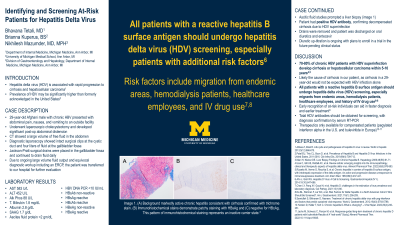Back


Poster Session E - Tuesday Afternoon
Category: Liver
E0602 - Identifying and Screening At-Risk Patients for Hepatitis Delta Virus
Tuesday, October 25, 2022
3:00 PM – 5:00 PM ET
Location: Crown Ballroom

Has Audio
- BT
Bhavana Tetali, MD
University of Michigan
Ann Arbor, MI
Presenting Author(s)
Bhavana Tetali, MD, Brianna Kuperus, BS, Nikhilesh Mazumder, MD, MPH
University of Michigan, Ann Arbor, MI
Introduction: Hepatitis delta virus (HDV) is associated with the most severe forms of viral hepatitis with rapid progression to cirrhosis and hepatocellular carcinoma. The prevalence of HDV may be significantly higher than formerly acknowledged in the United States, making it doubly important to identify at-risk individuals.
Case Description/Methods: A recently emigrated 29-year-old Afghani male with chronic hepatitis B virus (HBV) infection presented with abdominal pain, nausea and vomiting to an outside facility. He underwent a laparoscopic cholecystectomy for symptomatic cholelithiasis. He developed postoperative abdominal distension with imaging initially concerning for a large bile leak however ERCP and a diagnostic laparoscopy were unrevealing. Four liters of fluid were drained, and a surgical drain was placed which continued to drain up to two liters of fluid daily. Upon transfer to our hospital, diagnostic workup showed AST 583 U/L, ALT 452 U/L, alkaline phosphatase 88 U/L, total bilirubin 1.8 mg/dL, and albumin 2.8 g/dL. HBV DNA PCR was < 10 IU/mL. HBV core antibodies, HBV e antibody, and HBV surface antigen were reactive. HBV e antigen and HBV surface antibody were non-reactive. Ascites fluid studies showed a high serum ascites albumin gradient and low protein, prompting a liver biopsy that showed cirrhosis (image 1). The patient was ultimately found to be positive for HDV antibody, confirming a diagnosis of cirrhosis due to HDV superinfection. The patient had his drains removed and was discharged on oral diuretics and entecavir for treatment of HBV infection. Diuretic uptitration is ongoing with plans to enroll in a trial in the future pending clinical status.
Discussion: In patients with chronic HBV who acquire HDV as a superinfection, 70-80% develop cirrhosis or hepatocellular carcinoma within 5-10 years. Superinfection is the likely cause of cirrhosis in our patient, as cirrhosis in a 29-year-old would not be expected with HBV infection alone. Early recognition of at-risk individuals can aid in faster diagnosis and earlier treatment. Screening should be considered in all individuals with a reactive HBV surface antigen, and especially in migrants from endemic areas, hemodialysis patients, healthcare employees, and IV drug users. Total HDV antibodies should be obtained for screening, with diagnosis confirmation by serum RT-PCR. Currently, therapeutic options are only available for compensated patients, with pegylated interferon alpha approved in the United States and buleviritide in Europe.

Disclosures:
Bhavana Tetali, MD, Brianna Kuperus, BS, Nikhilesh Mazumder, MD, MPH. E0602 - Identifying and Screening At-Risk Patients for Hepatitis Delta Virus, ACG 2022 Annual Scientific Meeting Abstracts. Charlotte, NC: American College of Gastroenterology.
University of Michigan, Ann Arbor, MI
Introduction: Hepatitis delta virus (HDV) is associated with the most severe forms of viral hepatitis with rapid progression to cirrhosis and hepatocellular carcinoma. The prevalence of HDV may be significantly higher than formerly acknowledged in the United States, making it doubly important to identify at-risk individuals.
Case Description/Methods: A recently emigrated 29-year-old Afghani male with chronic hepatitis B virus (HBV) infection presented with abdominal pain, nausea and vomiting to an outside facility. He underwent a laparoscopic cholecystectomy for symptomatic cholelithiasis. He developed postoperative abdominal distension with imaging initially concerning for a large bile leak however ERCP and a diagnostic laparoscopy were unrevealing. Four liters of fluid were drained, and a surgical drain was placed which continued to drain up to two liters of fluid daily. Upon transfer to our hospital, diagnostic workup showed AST 583 U/L, ALT 452 U/L, alkaline phosphatase 88 U/L, total bilirubin 1.8 mg/dL, and albumin 2.8 g/dL. HBV DNA PCR was < 10 IU/mL. HBV core antibodies, HBV e antibody, and HBV surface antigen were reactive. HBV e antigen and HBV surface antibody were non-reactive. Ascites fluid studies showed a high serum ascites albumin gradient and low protein, prompting a liver biopsy that showed cirrhosis (image 1). The patient was ultimately found to be positive for HDV antibody, confirming a diagnosis of cirrhosis due to HDV superinfection. The patient had his drains removed and was discharged on oral diuretics and entecavir for treatment of HBV infection. Diuretic uptitration is ongoing with plans to enroll in a trial in the future pending clinical status.
Discussion: In patients with chronic HBV who acquire HDV as a superinfection, 70-80% develop cirrhosis or hepatocellular carcinoma within 5-10 years. Superinfection is the likely cause of cirrhosis in our patient, as cirrhosis in a 29-year-old would not be expected with HBV infection alone. Early recognition of at-risk individuals can aid in faster diagnosis and earlier treatment. Screening should be considered in all individuals with a reactive HBV surface antigen, and especially in migrants from endemic areas, hemodialysis patients, healthcare employees, and IV drug users. Total HDV antibodies should be obtained for screening, with diagnosis confirmation by serum RT-PCR. Currently, therapeutic options are only available for compensated patients, with pegylated interferon alpha approved in the United States and buleviritide in Europe.

Figure: Image 1: (A) Trichrome stain showing markedly active chronic hepatitis consistent with cirrhosis. (B) Immunohistochemical stains demonstrate patchy staining with HBV surface antigen but (C) negative for HBV core antigen.
Disclosures:
Bhavana Tetali indicated no relevant financial relationships.
Brianna Kuperus indicated no relevant financial relationships.
Nikhilesh Mazumder indicated no relevant financial relationships.
Bhavana Tetali, MD, Brianna Kuperus, BS, Nikhilesh Mazumder, MD, MPH. E0602 - Identifying and Screening At-Risk Patients for Hepatitis Delta Virus, ACG 2022 Annual Scientific Meeting Abstracts. Charlotte, NC: American College of Gastroenterology.
